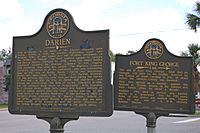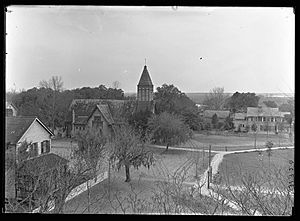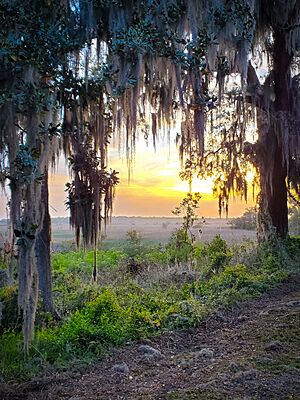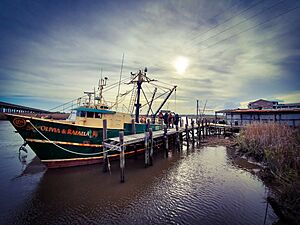Darien, Georgia facts for kids
Quick facts for kids
Darien, Georgia
|
||
|---|---|---|
|
City
|
||
| City of Darien | ||
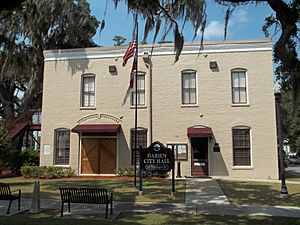
Darien City Hall
|
||
|
||
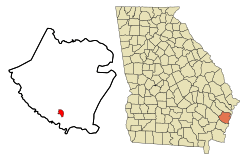
Location in McIntosh County and the state of Georgia
|
||
| Country | United States | |
| State | Georgia | |
| County | McIntosh | |
| Area | ||
| • Total | 24.04 sq mi (62.26 km2) | |
| • Land | 21.16 sq mi (54.82 km2) | |
| • Water | 2.87 sq mi (7.44 km2) | |
| Elevation | 30 ft (9 m) | |
| Population
(2020)
|
||
| • Total | 1,460 | |
| • Density | 68.98/sq mi (26.63/km2) | |
| Time zone | UTC-5 (Eastern (EST)) | |
| • Summer (DST) | UTC-4 (EDT) | |
| ZIP code |
31305
|
|
| Area code(s) | 912 | |
| FIPS code | 13-21716 | |
| GNIS feature ID | 0331512 | |
Darien (pronounced like "dairy-en") is a city in Georgia, United States. It is the main city, or county seat, of McIntosh County.
Darien is located on Georgia's coast, right where the Altamaha River meets the ocean. It's about 50 miles (80 km) south of Savannah. Darien is the second-oldest planned city in Georgia. It was first called New Inverness. In 2020, about 1,460 people lived in Darien.
Contents
History
How Darien Was Settled
The British built Fort King George in 1721 near where Darien is today. This fort was the southernmost British outpost in North America at the time. Spanish attacks led to the fort being left in 1727. Its remains are the oldest fort found on the Georgia coast.
The town of Darien, originally named New Inverness, was started in January 1736. It was founded by Scottish Highlanders. These settlers were brought by James Oglethorpe to be soldier-farmers. Their job was to protect Georgia's borders from the Spanish in Florida and the French in Alabama.
On January 10, 1736, 177 people, including families, arrived on a ship called the Prince of Wales. They came to build Darien. The town was named after the Darien Scheme, an older Scottish colony in Panama. Among the first settlers were Lachlan McGillivray, who became a famous trader, and Lachlan McIntosh, a leader in the American Revolutionary War.
Most of the Scottish settlers came from around Inverness and spoke Gaelic. When Oglethorpe visited in February, they had already built a cannon battery, a guardhouse, a storehouse, a chapel, and many huts. Darien was planned using the famous Oglethorpe Plan.
The settlers also worked hard on military forts. By March, they started building Fort St. Andrews on Cumberland Island and Fort St. George on the St. Johns River. In 1736, the British left Fort St. George after an agreement with Spanish officials. In the same year, Darien settlers began building Fort Frederica on St. Simons Island, a few miles south of Darien.
The Scottish settlers who had their travel paid for by the colony were organized into two groups: the Highland Independent Company of Foot (soldiers on foot) and the Highland Rangers (soldiers on horseback). By 1737, the constant military work was tough. So, 44 more Highland settlers arrived to help the town grow.
At first, the settlers tried to grow crops, but their harvests were poor. They then focused on raising cattle and cutting timber to sell in nearby Savannah.
In 1739, 18 important members of the Darien colony signed the first petition against slavery in Georgia. They asked Oglethorpe and the Trustees not to allow slavery. The Highlanders' request worked for a while. However, slavery was allowed ten years later in 1749. This happened because the colony needed more workers to make money.
Conflicts with Spanish and Native American forces continued. The War of Jenkins' Ear began in October 1739. In November, after two Scottish soldiers were killed by Spanish-allied Native Americans, the Darien settlers joined forces with soldiers from South Carolina. They captured several Spanish forts before trying to attack St. Augustine. The Spanish won the Battle of Fort Mose, and 51 Darien settlers were killed or captured.
After this battle, some settlers left Darien for South Carolina. By 1741, another ship arrived with 43 colonists. These new colonists received land grants that would pass to their children, both male and female. This was a change from the usual practice where land only went to male children. The Trustees wanted to keep settlers in the colony.
Civil War and After
On June 11, 1863, during the American Civil War, Union troops destroyed most of Darien. This included the homes of both white and Black residents. This event happened more than a year before Sherman's March to the Sea.
The destruction of the city, which was not defended and not very important for military strategy, was carried out by the 54th Massachusetts Volunteers. They were led by Colonel Robert Gould Shaw, who was not happy about the order. The 2nd South Carolina Volunteers, led by Colonel James Montgomery, also took part. Colonel Montgomery ordered the town to be looted and burned. His troops took many things, while Shaw told his soldiers to take only what they needed for camp. Shaw later called the raid a "Satanic action."
The First African Baptist Church, believed to be the oldest African-American church in the county, was also destroyed. It was rebuilt later and became a meeting place for the 20th-century Civil Rights Movement.
After the U.S. Army destroyed Darien, gunboats were used to blockade the port. Troops took food from residents and farms in McIntosh County. The only local defenders were older white men. On August 3, 1864, Union troops captured 23 of these men at a church. They were sent to prisons in the North.
After the Civil War, Darien was rebuilt. Colonel Robert Gould Shaw's family helped with some money. He had felt ashamed about his part in destroying Darien.
In the early 1900s, Darien was a major port for shipping lumber in the Southeast. When most of the timber was gone, Darien became a fishing village. It became known for Georgia wild shrimp and was once famous for its oysters.
Today, there are 32 historical markers near Darien and 42 in McIntosh County. Darien has grown in recent years. When Interstate 95 was built, it passed close to the city. This led to new businesses like restaurants, gas stations, and hotels near the highway. However, downtown Darien has also become popular again, focusing on its history and waterfront. Many new businesses have opened, making the city center a great place to walk around.
Geography
Darien is located at 31°22′16″N 81°25′51″W / 31.37111°N 81.43083°W.
According to the United States Census Bureau, the city covers about 2.0 square miles (5.2 square kilometers) of land.
Demographics
| Historical population | |||
|---|---|---|---|
| Census | Pop. | %± | |
| 1850 | 550 | — | |
| 1860 | 570 | 3.6% | |
| 1870 | 547 | −4.0% | |
| 1880 | 1,543 | 182.1% | |
| 1890 | 1,491 | −3.4% | |
| 1900 | 1,739 | 16.6% | |
| 1910 | 1,391 | −20.0% | |
| 1920 | 823 | −40.8% | |
| 1930 | 937 | 13.9% | |
| 1940 | 1,015 | 8.3% | |
| 1950 | 1,380 | 36.0% | |
| 1960 | 1,569 | 13.7% | |
| 1970 | 1,826 | 16.4% | |
| 1980 | 1,731 | −5.2% | |
| 1990 | 1,783 | 3.0% | |
| 2000 | 1,719 | −3.6% | |
| 2010 | 1,975 | 14.9% | |
| 2020 | 1,460 | −26.1% | |
| U.S. Decennial Census | |||
| Race | Number of People | Percentage |
|---|---|---|
| White (not Hispanic) | 810 | 55.48% |
| Black or African American (not Hispanic) | 542 | 37.12% |
| Native American | 14 | 0.97% |
| Asian | 15 | 1.03% |
| Other/Mixed | 58 | 3.97% |
| Hispanic or Latino | 21 | 1.44% |
In 2020, there were 1,460 people living in Darien. There were 957 households and 609 families.
Education
McIntosh County School District
The McIntosh County School District serves students in Darien. It has two elementary schools, one middle school, and one high school. The district has 121 full-time teachers and teaches 1,979 students.
- Todd Grant Elementary School
- McIntosh County Middle School
- McIntosh County Academy
Gallery
See also
 In Spanish: Darien (Georgia) para niños
In Spanish: Darien (Georgia) para niños



